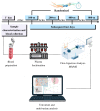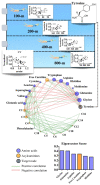Plasma Amino Acids and Acylcarnitines Are Associated with the Female but Not Male Adolescent Swimmer's Performance: An Integration between Mass Spectrometry and Complex Network Approaches
- PMID: 36552244
- PMCID: PMC9774704
- DOI: 10.3390/biology11121734
Plasma Amino Acids and Acylcarnitines Are Associated with the Female but Not Male Adolescent Swimmer's Performance: An Integration between Mass Spectrometry and Complex Network Approaches
Abstract
The main aim of this study was to compare the performance over different distances, the critical velocity (CV), and plasma acylcarnitines/amino acids of male and female adolescent swimmers. Moreover, we applied the complex network approach to identify which molecules are associated with athletes' performances. On the first day under a controlled environment, blood samples were collected after 12 h of overnight fasting. Performance trials (100, 200, 400, and 800-m) were randomly performed in the subsequent four days in a swimming pool, and CV was determined by linear distance versus time mathematical function. Metabolomic analyses were carried out on a triple quadrupole mass spectrometer performing electrospray ionization in the positive ionization mode. No difference was observed between the performance of male and female swimmers. Except for 200-m distance (p = 0.08), plasma tyrosine was positively and significantly associated with the female times during the trials (100-m, p = 0.04; 400-m, p = 0.04; 800-m, p = 0.02), and inversely associated with the CV (p = 0.02). The complex network approach showed that glycine (0.406), glutamine (0.400), arginine (0.335), free carnitine (0.355), tryptophan (0.289), and histidine (0.271) were the most influential nodes to reach tyrosine. These results revealed a thread that must be explored in further randomized/controlled designs, improving the knowledge surrounding nutrition and the performance of adolescent swimmers.
Keywords: athletic performance; critical velocity; metabolism; metabolomics; swimming.
Conflict of interest statement
The authors declare no conflict of interest.
Figures





Similar articles
-
Associations among sleep, hematologic profile, and aerobic and anerobic capacity of young swimmers: A complex network approach.Front Physiol. 2022 Aug 24;13:948422. doi: 10.3389/fphys.2022.948422. eCollection 2022. Front Physiol. 2022. PMID: 36091363 Free PMC article.
-
Predicting a nation's olympic-qualifying swimmers.Int J Sports Physiol Perform. 2015 May;10(4):431-5. doi: 10.1123/ijspp.2014-0314. Epub 2014 Oct 28. Int J Sports Physiol Perform. 2015. PMID: 25365394
-
Critical velocity and lactate threshold in young swimmers.Int J Sports Med. 2006 Feb;27(2):117-23. doi: 10.1055/s-2005-837487. Int J Sports Med. 2006. PMID: 16475057 Clinical Trial.
-
Warm-up and performance in competitive swimming.Sports Med. 2014 Mar;44(3):319-30. doi: 10.1007/s40279-013-0117-y. Sports Med. 2014. PMID: 24178508 Review.
-
Sex Differences in Swimming Disciplines-Can Women Outperform Men in Swimming?Int J Environ Res Public Health. 2020 May 22;17(10):3651. doi: 10.3390/ijerph17103651. Int J Environ Res Public Health. 2020. PMID: 32456109 Free PMC article. Review.
Cited by
-
Revealing the regulatory impact of nutrient on the production of (R)-2-(4-Hydroxyphenoxy)propanoic acid by Beauveria bassiana biofilms through comparative transcriptomics analyse.Bioprocess Biosyst Eng. 2024 Nov;47(11):1803-1814. doi: 10.1007/s00449-024-03070-9. Epub 2024 Jul 30. Bioprocess Biosyst Eng. 2024. PMID: 39080012
-
Combined Association of Plasma Metabolites with Body Mass Index and Physical Activity Level.Biology (Basel). 2024 Dec 20;13(12):1074. doi: 10.3390/biology13121074. Biology (Basel). 2024. PMID: 39765741 Free PMC article.
-
Glycerophospholipids in Red Blood Cells Are Associated with Aerobic Performance in Young Swimmers.Nutrients. 2024 Mar 7;16(6):765. doi: 10.3390/nu16060765. Nutrients. 2024. PMID: 38542678 Free PMC article.
References
-
- World Health Organization . Nutrition in Adolescence: Issues and Challenges for the Health Sector: Issues in Adolescent Health and Development. WHO Press; Geneva, Switzerland: 2005.
-
- Ferens K., Przeliorz-Pyszczek A. Nutritional principles of adolescent swimmers. Cent. Eur. J. Sport Sci. Med. 2019;25:51–61. doi: 10.18276/cej.2019.1-06. - DOI
Grants and funding
LinkOut - more resources
Full Text Sources

